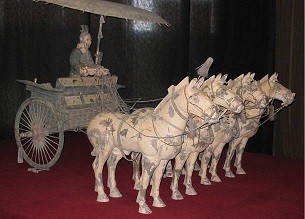Chinese archaeologists have found five well-preserved horse-drawn vehicles with four sacrificed horses, in the corridor of the main tomb of “Haihunhou” (Marquis of Haihun), the Xinhua News Agency reported.
The report said that the discovery was made at the burial site located in Nanchang, capital of East China's Jiangxi Province. The site dates back to the Western Han Dynasty (206 B.C. - A.D. 25) and covers an area of about 40,000 square meters. It comprises eight tombs and a dedicated area for chariots, with walls that stretch about 900 meters.
Archaeologists believe that the main tomb is that of Liu He, the grandson of Emperor Wu, the greatest ruler of the Han Dynasty, considered as one of the most prosperous periods in China's history, the report added.
Liu, who was given the title "Haihunhou," was deposed as emperor after only 27 days, after he was dethroned by the royal clan due to his lack of talent and morals. Haihun is the ancient name of a very small kingdom in the north of Jiangxi.
Xin Lixiang, one of the archaeologists, said that the chariots pulled by four horses that were found in the tomb were only used by the most senior members of the Han Dynasty.
Xin said that more than 3,000 accessories embellished with gold and silver were also discovered by the team.
"Some of the accessories are not from the Central Plain," said Hu Dongbo, a professor at the School of Archaeology and Museology of Peking University.
"It is possible that they came from western regions," Hu said.
More than 10 tons of Wuzhu bronze coins were also discovered by the team, and more than 10,000 gold, bronze and iron items were uncovered along with jade articles, wood tablets and bamboo slips.
The report said that archaeologists will look for items locked in the coffin of the central mausoleum in the next stage of the archaeological work.
The excavation of the site began in 2011.



























